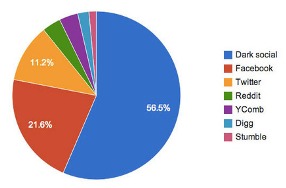Content Strategy: Your Eyes in the Dark Web World
Invisible social traffic sources. Google keeping us in the dark with “Not Provided” traffic sources. With factors adding to the age-old challenge of accurate attribution, what’s a marketer to do?
Here’s the story, curated from around the Web last week. New technologies add new obstacles to measuring the effect of our marketing efforts. And while it may seem like the answer is a higher tech way to track users movements online, it’s probably more likely to be the simple standard: know your audience.
When you know your audience, where they go, what they need, what they use, what they care about, you reach them in a way that transcends tech and resonates in all mediums.
| We Completely Misunderstand How the Web Works The Atlantic
The mysterious presence of “dark social” sparked a lot of discussion about the shortcomings of tracking traffic and how we share and spread content outside the reach of traditional analytics.
|
Traffic generated by Facebook and Twitter is just a fraction of the traffic driven by social activity online. Yet, these social sources are overrepresented by analytics programs as they’re easily tracked. Not accounted for is the significant volume of “dark social” activity, including email and chat.
For The Atlantic, more than half of social traffic may be coming from unknown sources, while about 22% comes from Facebook and about 11% from Twitter. An analysis of a broader set of media publishers show nearly 70% of social traffic falls under the dark category. The dirty secret of analytics is that most traffic sources are currently untraceable. |
| Happy Birthday “Not Provided” – One Year Since Google Began Withholding Search Terms Search Engine Land
A year ago, Google began encrypting searches for signed-in users, so that the terms they searched for were no longer passed to publishers, except for advertisers.
|
Add to the problem of attribution for SEO, the fact that Google has obscured traffic data coming from signed in users. A year ago, Google anonymized signed-in Google users search traffic data — a move that enables Google to deliver more personalized results to users and avoiding some user privacy concerns.
The search engine is withholding from webmasters queries that reveal personal needs, motivations and identifiers. Google initially predicted that most websites would see single digit percentages of traffic under the “not provided” designation, however some sites see half their traffic hidden in Google Analytics. |
| Marketing at Crossroads: Why Content is Key and Who Takes Credit B2Bento
A chat between Vikas Gulati from Vserv.mobi and Sanchit Sanga from Mindshare is recorded on video. Their convo explores the role of content and content strategy in marketing and effective attribution techniques. B2Bento.tv – Marketing at Crossroads Part 3: Why Content is Key and Who Takes Credit from B2Bento on Vimeo. |
Of course, the problem of accurate attribution was around before digital media. “How do I quantify the value of ” TV, radio, billboards? Sanga and Gulati say 40% of search queries are driven by TV ads and 30% of search queries can be traced to print.
So, when search marketers look at the big picture, where our search traffic data is obscured by Google, where much of social sharing is cloaked by darkness, there really is only one effective strategy: focusing on content. Every medium plays a role in what these speakers call the “surround sound” effect of marketing. The best way to direct your marketing efforts is to understand your consumer and use that to guide your content strategy. |

5 Replies to “Content Strategy: Your Eyes in the Dark Web World”
Hello, Virginia thanks four your suggestion. Please let me know if u have any automation software for keyword ranking check.
Thanks in advance.
Vaibhav
Vaibhav: Thanks for reading. We do have the SEOToolSet, which includes a Ranking Monitor. You can learn more at https://www.SEOToolSet.com.
Hey Virginia, if Google is not providing the perfect data than what should we have to do for tracking data? I have heard some where that every site have own log data which should be match with Google analytics? Other option might be Omniture.
Can we have the data from LOG files & compare it? I have never seen & tried it before, so asking for help to guide me if it is possible or guide me other ways.
Thanks,
Arun, good question. Web analytics and log file analysis are not really comparable. Log file analysis will not give you as much information about visitor click paths or time spent on pages, and it is limited to HTTP/S requests. For web analytics, Google isn’t the only solution. You mention Omniture, and there are many others available to meet a webmasters’ needs: http://en.wikipedia.org/wiki/List_of_web_analytics_software. I hope that helps.
LEAVE A REPLY











